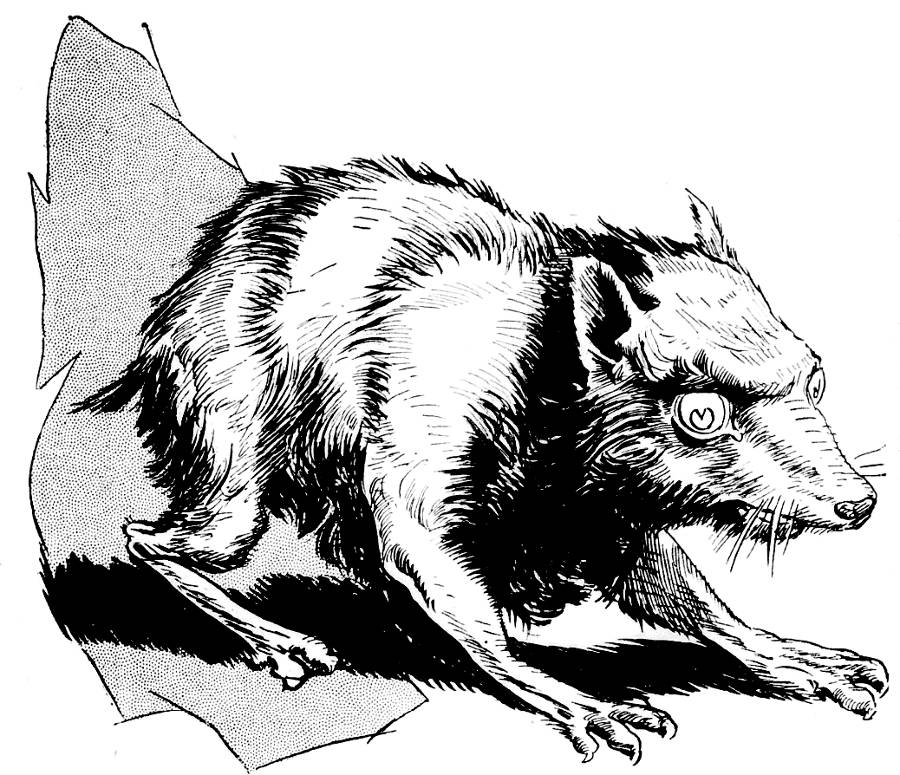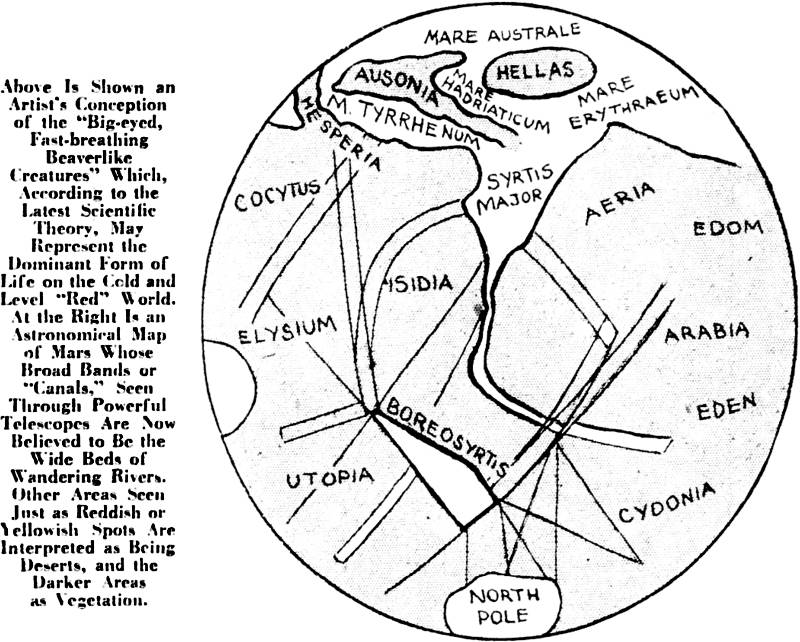

SINCE scientists, after years of earnest and competent research, have been unable to detect one clear sign of manlike life on Mars, an amazing theory is now being presented to explain why the red planet may be inhabited by a race of beavers. It is a fascinating story of evolution.
Man and man’s active mind are believed to be products of the Great Ice Age, for that time of stress and competition on earth is what is supposed to have turned mankind’s anthropoid ancestors’ into men. The period of ice and cold over wide areas of the earth was caused, at least in part, by the elevation of continents and mountain ranges. On Mars, no mountain ranges exist, and it probably never had an Ice Age.
It is on these hypotheses, as Thomas Elway explains in Popular Science Monthly, that science bases its assumption that there is no human intelligence on Mars, and that animal life on the planet is still in the age of instinct. The thing to expect on Mars, then, is a fish life much like that on earth, the emergence of this fish life onto the land, and the evolution of these Martian land-fishes into reptile like creatures. Finally, animals resembling the earth’s present rodents
like rats, squirrels and beavers, would make their appearance.
“The chief reason to expect this final change of Martian reptiles into primitive mammals,” says Mr. Elway, “lies in the fact that on earth this evolution seems to have been forced by change able weather. And Mars now.possesses seasonal changes like those on earth. “Pure biological reasoning makes it probable, therefore, that the evolution of warm-blooded animals may have occurred on Mars much as it did here. There seems no reason to believe that Martian life has gone farther than that.
Mars is a relatively changeless planet. Biologists suppose that the rise and fall of mountains, the increase and decrease in volcanic activity, and the ebb and flow of climate forced life on earth along its upward path. Martian life of recent ages seems to have lacked these natural incentives to better things.
“Now, there is one creature on earth for the development of whose counterpart the supposed Martian conditions would be ideal. That animal is the beaver. It is either land-living or water living. It has a fur coat to protect it from the 100 degrees below zero of the Martian night.
“Martian beavers, of course, would not be exactly like those on earth. That they would be furred and water-loving is probable. Their eyes might be larger than those of the earthly beaver be cause the sunlight is not so strong, and their bodies might be larger because of lesser Martian gravity. Competent digging tools certainly would be provided on their claws. The chests of these Martian beavers would be larger and their breathing far more active, as there is less oxygen in the air on Mars.
“Such beaver-Martians are nothing more than pure speculation, but the idea is based upon the known facts that there is plenty of water on Mars; that vegetation almost certainly exists there; that Mars has no mountains and could scarcely have had an Ice Age; and that evidences of Martian life are not accompanied by signs of intelligence.
“Herds of beaver-creatures are at least a more reasonable idea than the familiar fictional one of manlike Martians digging artificial water channels with vast machines or the still more fantastic notion of octopuslike Martians sufficiently intelligent to plan the conquest of the earth.”
Any deduction about the life forms on Mars or other planets, in the opinion of leading astronomers, must start, if it is to be at all reasonable, with the idea of the distinguished Swedish scientist. Dr. Svante Arrhenius, of one kind of life-germ pervading the entire solar system. There is no reasonable way even to guess the form of this life germ. It may, perhaps, have drifted, a tiny living spores, from planet to planet, whirled through space by the pressure of light.
Whatever its form, the life-germ, biologists assume, probably developed on Mars, much as it did on earth, in oceans which have evaporated in the course of ages.
The theory that Martian life evolved along lines similar to those followed by evolution of life on earth is supported by at least one definite fact. Careful spectroscopic studies at Mt. Wilson Observatory, near Pasadena, Calif., and elsewhere have disclosed that gaseous oxygen exists in the Martian atmosphere. The presence of oxygen gas is highly significant, since the only known way in which any planet can obtain supply of this gas is through the life activities of plants.
Following the lead of the great expert in Martian astronomy, the late Professor Percival Lowell, astronomers long have recognized on Mars dark colored spots and markings which are believed to be plains or valleys covered with vegetation. The oxygen which spectroscopes show in the Martian air is taken as another proof that this vegetation exists.
Since the activity of plants is the only known process of cosmic chemistry by which free oxygen can be produced on the surface of a cooled planet, the presence of oxygen in the rarefied air of Mars indicates that vegetation there must have produced oxygen out of water and sunlight as it has done on earth. It is difficult to exaggerate the importance to Martian theorizing of the definite fact that Mars has oxygen and, therefore, vegetation.
One of the best signs of intelligence on Mars, Dr. Clyde Fisher, of the American Museum of Natural History, New York City, said recently, would be some indication of artificial light on the planet. Undoubtedly, lighted cities on Mars could be seen through the telescopes now in use.
However, as Mr. Elway points out, there is one condition that prevents satisfactory and conclusive observation. When Mars is closest to the earth, both planets are on the same side of the sun. Then only the sunlit side of Mars is seen. To see any part of the night side of Mars, observation must be made when it is part way around in its orbit toward the far side of the sun, so that a slice of both the dark and the lighted sides can be seen.
When even a part of the night side is visible. Mars is relatively far away and difficult to sec clearly. The Martians, if there are any, would not have equal difficulty in observing the dark side of the earth, for when the two planets are nearest to each other, the earth is showing Mars its dark side.
These consequences of the orbits in which the two planets move might make it difficult for the dim glow of lighted Martian villages, were any such in existence, to be detected from the earth. Cities as bright as New York or Paris, on the other hand, undoubtedly would be visible.
Other students of the subject, how ever, say it is possible that Martian civilization may correspond to that of an earlier, pre-artificial light era on earth. In any case, astronomers agree that there is a practical certainty that Mars possesses kinds of life below human intelligence.
New Britain Herald, New Britain, Conn., December 06, 1930
